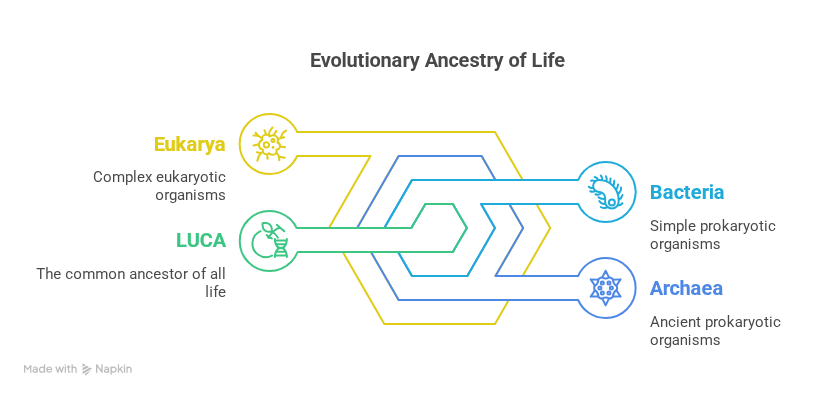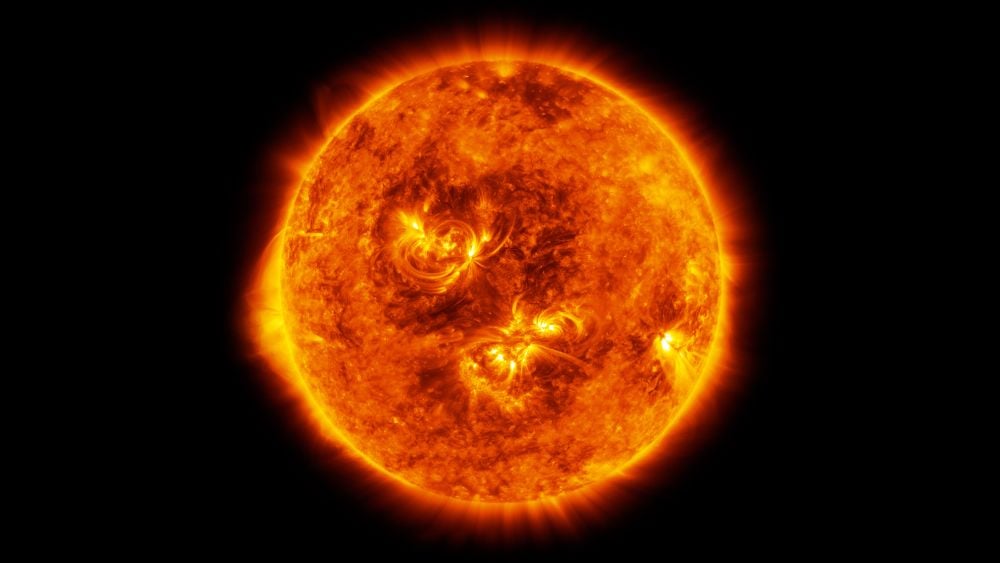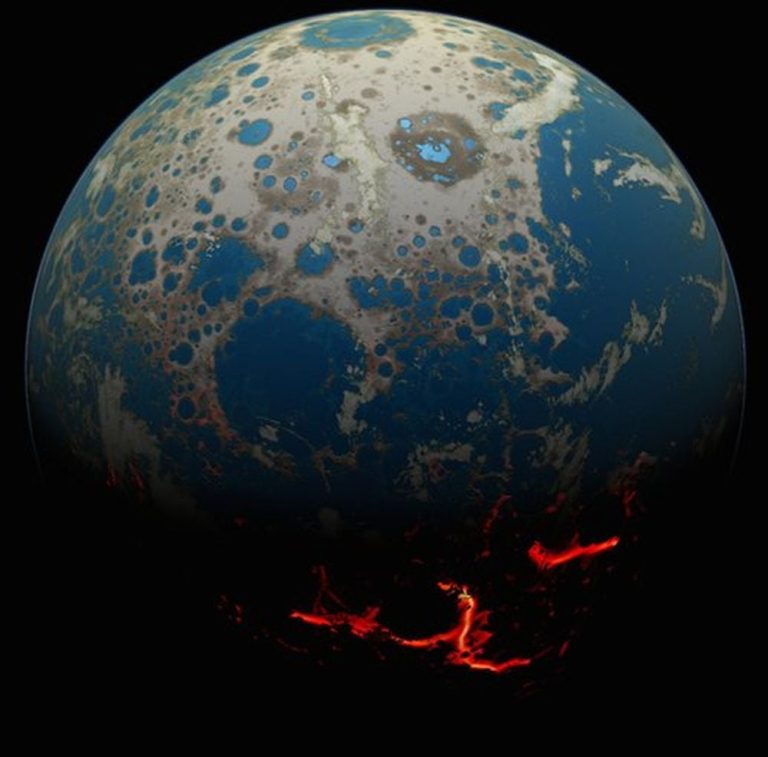New Study Reveals Life on Earth Started Within Millions of Years After Formation
Life on Earth emerged extremely rapidly—within a few hundred million years after the planet formed—supported by multiple lines of geological and genetic evidence, and Bayesian analysis shows strong odds in favor of quick abiogenesis under Earth-like conditions.
Summary
- Evidence of microbial life appears as early as 4.2 billion years ago, only ~300 million years after Earth’s formation, based on isotopic and microfossil data.
- Stromatolites dating back 3.7 billion years provide physical fossils of early cyanobacteria.
- Isotope signatures in ancient Australian rocks suggest biological activity at 4.1 billion years ago.
- Filamentous structures in Canadian rocks at 4.28 billion years may represent some of the oldest biotic remains.
- Genetic reconstructions place the Last Universal Common Ancestor (LUCA) between 3.6 and 4.2 billion years ago.
- Bayesian odds ratios exceed 10:1 in favor of rapid abiogenesis when considering the latest LUCA date.
- The weak anthropic principle explains why we observe early life: only planets where life happens quickly can produce observers before the biosphere ends.
- Predictions suggest Earth’s habitable window lasts ~5–6 billion years, so early abiogenesis was necessary for intelligent life to evolve.
- Rapid emergence of life on Earth analogs implies life may be common where conditions permit.
- Open questions remain about panspermia versus in-situ origin, and whether Earth is typical or rare.

The Dawn of Life
Earth formed about 4.54 billion years ago. Almost at once, the planet faced intense heat, volcanoes, and bombardment by asteroids. Yet within a few hundred million years, simple life appeared. This speed is astonishing given the complexity of even the simplest cells. Scientists now agree that by 4.2 billion years ago, conditions allowed chemicals to assemble into self-replicating systems, marking life’s beginning.
Early Earth had a thin crust, volcanic activity, and a partially molten surface. As it cooled, water condensed to form oceans. These seas provided a medium for organic molecules to concentrate and react. Energy sources like UV light, hydrothermal vents, and lightning drove the formation of increasingly complex molecules, eventually leading to the first protocells.
Clues from Ancient Rocks
Geologists have uncovered multiple lines of evidence pushing life’s origin earlier and earlier. In Greenland, 3.7-billion-year-old stromatolites—layered structures built by microbial mats—are some of the oldest clear fossils. In Western Australia, isotope ratios of carbon in 4.1-billion-year-old rocks hint at biological processing, since living organisms favor lighter carbon isotopes. Even older, 4.28-billion-year-old filamentous structures in Canadian zircons might record microbial activity, though debate continues.
Table 1. Early Evidence for Life on Earth
| Evidence Type | Age (Gya) | Location |
|---|---|---|
| Isotope signatures (carbon ratios) | 4.10 | Western Australia |
| Filamentous structures in zircons | 4.28 | Nuvvuagittuq, Canada |
| Stromatolite microfossils | 3.70 | Greenland |
These data show life began almost as soon as the planet cooled enough to hold liquid water. Each new discovery pushes the timeline closer to Earth’s formation, implying that life emerges quickly when conditions allow.
The Role of LUCA
Biologists reconstruct the Last Universal Common Ancestor (LUCA), the cell from which all current life descends. Recent genetic studies date LUCA to roughly 4.2 billion years ago, aligning with the oldest geological signs of life. LUCA was likely a complex microbe with hundreds or thousands of genes, capable of basic metabolism and replication, possibly living near hydrothermal vents or shallow ponds.
LUCA’s features hint at how early life harnessed energy and nutrients. Its genetic toolkit included proteins for copying RNA and building cell membranes. Traces of an immune-like system suggest viruses were already present, driving early evolutionary arms races. Thus, LUCA represents a well-adapted organism, not a simple blob, reflecting rapid evolution in Earth’s first few hundred million years.

Understanding Rapid Abiogenesis
Why did life appear so fast? American astronomer David Kipping applied Bayesian analysis to Earth’s timeline, comparing fast versus slow scenarios for abiogenesis (life’s origin) on Earth-like planets. He calculated odds ratios based on fossil ages and LUCA’s date. Early microfossils (3.7 Gya) gave odds of about 3:1 for fast origin; isotope data (4.1 Gya) raised that to 9:1. The new LUCA age (4.2 Gya) pushes odds above the 10:1 threshold, marking strong evidence for rapid abiogenesis.
“For the first time, we have formally strong evidence that favors the hypothesis that life rapidly emerges in Earth-like conditions.” – David Kipping, Columbia University Astrobiology
Table 2. Bayesian Odds for Rapid Abiogenesis
| Evidence Source | Age (Gya) | Odds Ratio (Fast vs Slow) |
|---|---|---|
| Microfossils | 3.70 | 3 : 1 |
| Carbon isotope signatures | 4.10 | 9 : 1 |
| LUCA genetic reconstruction | 4.20 | 13 : 1 |
Kipping also considered the weak anthropic principle: observers exist only on planets where life began early enough for intelligence to evolve before the biosphere ends (in ~5–6 Gyr). His results hold across a range of biosphere lifespans and even hypothetical ancient civilizations, indicating that rapid abiogenesis is the simplest explanation.
Implications for Life Beyond Earth
If life arises quickly under suitable conditions, Earth may not be unique. Planets with liquid water and energy sources might routinely spawn biology. This boosts prospects for finding life on Mars, icy moons, or exoplanets in habitable zones. However, Earth may still be special if early conditions (e.g., specific chemistry, volcanic activity) are rare. Until we detect independent life elsewhere, our single-planet sample limits certainty.
Searching for biosignatures—gases like oxygen or methane, or fossil structures—on Mars and exoplanets is now more urgent. Upcoming missions (e.g., Mars Sample Return, Europa Clipper, JWST observations) may reveal whether rapid abiogenesis is common or Earth’s quick start was a fluke.
Facts
- The term abiogenesis means “life from non-life.”
- Stromatolites are still found today in places like Shark Bay, Australia.
- LUCA’s genome may have encoded over 2,600 proteins, similar to some modern bacteria.
- The Late Heavy Bombardment (4.1–3.8 Gya) didn’t prevent life’s origin; it may have even driven chemical complexity.
- The Silurian hypothesis asks whether evidence of an ancient civilization would survive millions of years on Earth.
References
- Kipping D. “Strong Evidence That Abiogenesis Is a Rapid Process on Earth Analogs.” Astrobiology (accepted). Astrobiology
- Kipping D. “Strong Evidence That Abiogenesis Is a Rapid Process on Earth Analogs.” arXiv:2504.05993 (2025). arXiv
- “However Life Got Started on Earth, It Didn’t Take Long.” Universe Today (2025). Universe Today
- Science.org. “Our last common ancestor lived 4.2 billion years ago—perhaps hundreds of millions years.” Science
- Wikipedia. “Last universal common ancestor.” Wikipedia
- Nature.com. “The nature of the last universal common ancestor and its impact on Earth.” Nature
- LiveScience. “Meet LUCA, the 4.2 billion-year-old cell.” Live Science
- Science Alert via NDTV. “Groundbreaking new study finds life on Earth emerged 4.2 billion years ago.” www.ndtv.com
- Wikipedia. “Anthropic principle.” Wikipedia
- Popular Mechanics. “Last Universal Common Ancestor Is Much Older Than We Thought.” popularmechanics.com

